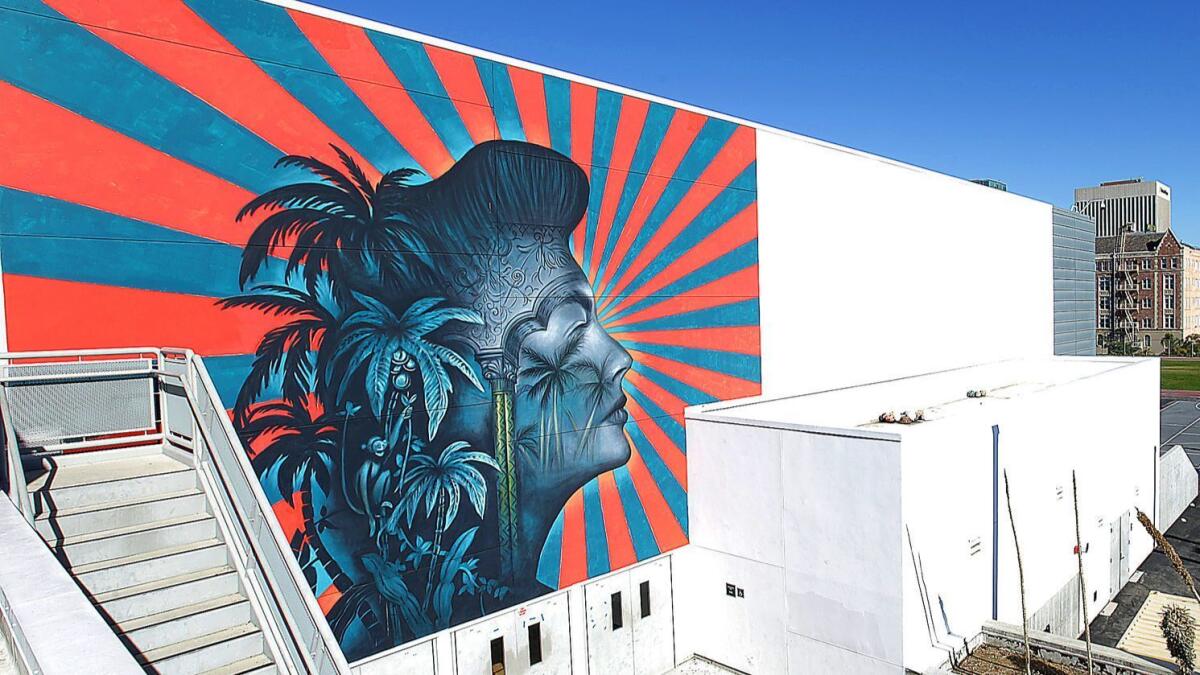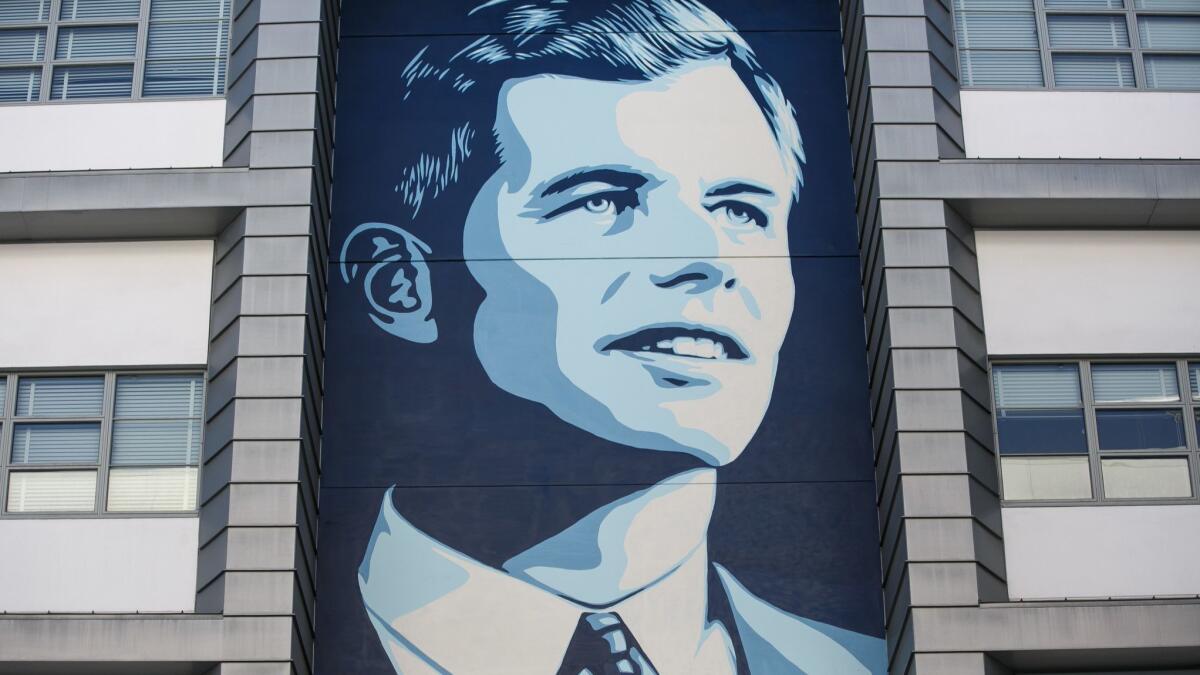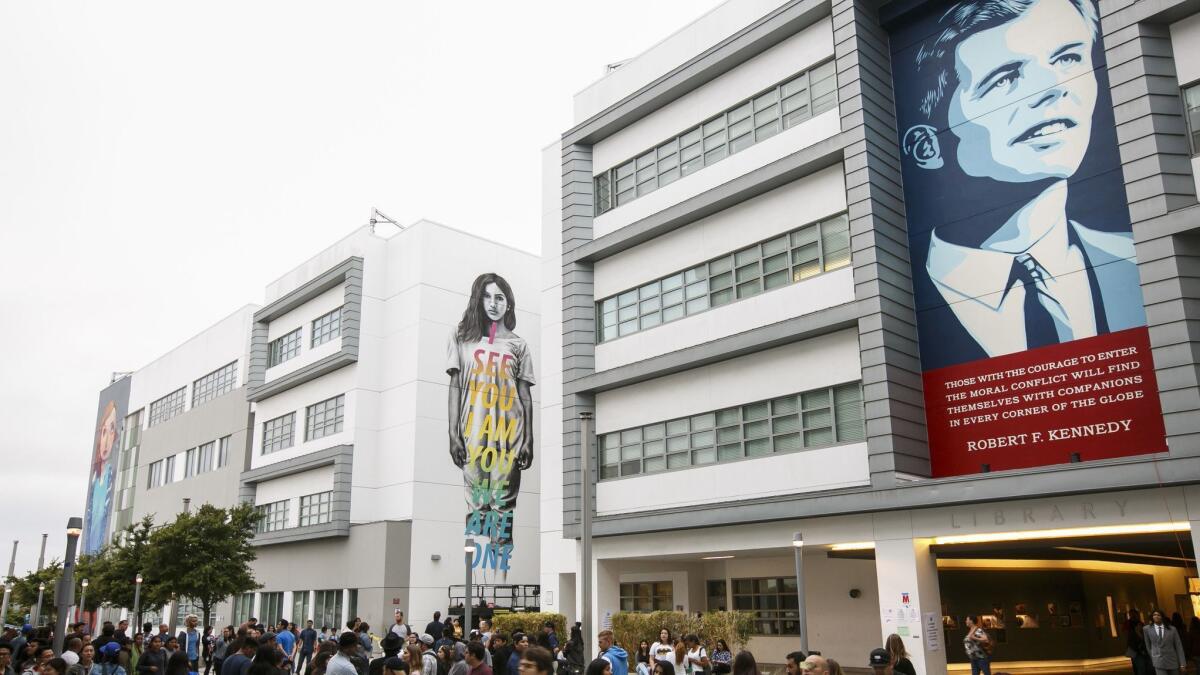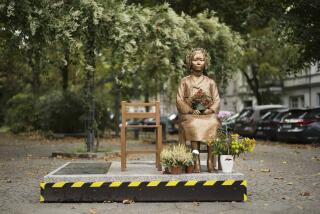Artist Shepard Fairey said he will insist on removal of his Robert F. Kennedy mural if LAUSD paints over controversial artwork at school

If the Los Angeles school district moves forward with plans to paint over a controversial mural at a Koreatown campus, artist Shepard Fairey said he will insist on the removal of his large outdoor portrait of Robert F. Kennedy at the school named after him.
In support of artist Beau Stanton, Fairey told The Times that he would call for the removal of his mural of Kennedy at the RFK Schools campus on Wilshire Boulevard. Kennedy was murdered at the site of the then-Ambassador Hotel in 1968.
“I’m proud of that mural,” Fairey said of his own work. “I’d love for that mural to stay, but this is the only leverage I have.”
On Sunday, one of Kennedy’s children voiced support for Stanton and for Fairey’s response.
The school district announced this month that it would erase Stanton’s mural after a group of Korean activists complained. The activists object to a representation of sun rays in the background because it reminds them of the Japanese imperial battle flag, which they associate with atrocities before and during World War II.
But Fairey and other critics say the L.A. Unified School District acted too hastily when it acquiesced to these complaints, which arose in recent months. The mural, which depicts actress Ava Gardner against a background of sun rays, was painted more than two years ago at the Robert F. Kennedy Community Schools complex.
Fairey said it’s important for the school district to understand that it made a poor decision in succumbing to what it apparently considered to be the path of least resistance. The artist said he wants to create and encourage some counter-resistance.
His Kennedy mural is arguably one of the school’s defining visual elements. It is on an outside wall of the entrance to the library, which is built on the footprint of the Ambassador Hotel ballroom where Kennedy gave his last speech, in 1968. Moments later, an assassin fatally shot the presidential candidate in a pantry area next to the kitchen.

On Sunday afternoon, Fairey provided an email he’d sent to school board President Monica Garcia, who represents Koreatown.
“I have talked to a teacher from RFK about where the students stand, and they overwhelmingly want the mural to stay,” Fairey wrote to Garcia. “If Beau’s mural is removed I will reach out to students to have them take part in my mural being painted over as a symbol of the sacrifices that are sometimes necessary to stand up for important principles.”
Neither Garcia nor other school board members have responded to a request for comment. Nor has Supt. Austin Beutner.
Fairey’s stand is the right one, said Maxwell Kennedy, an attorney and author.
“We are aware of of the power of symbols and we stand with Shepard Fairey and Beau Stanton against the ... censorship of public art,” Kennedy said in a statement provided to The Times. “Symbols can be hurtful and there are some symbols that should not be displayed. But rays of light are synonymous in this country with hope.”
Members of the Kennedy clan have long taken an interest in the school. Key family members played an important role in signaling they wanted to see the school built — even if it meant tearing down the historic hotel where RFK was killed.

Stanton’s mural is intended as a celebration of the Cocoanut Grove, the famous Hollywood watering hole that was once located nearby. The profile of the screen icon is its dominant feature, with a monkey, palm trees and a Moorish arch superimposed on her face to evoke the club’s exotic decor.
What disturbs the Korean activists, however, are the sun rays emanating from Gardner’s face. The Japanese battle flag has 32 bands of uniform proportions, in alternating red and white around a centered red disk representing the sun. Stanton’s mural has 44 varying bands of blue and reddish-orange, surrounding a much larger and different central image. Sun rays are a common art and design motif.
“Yeah, these things happened and they’re part of a terrible history, but this mural has nothing to do with that,” Fairey said Saturday. “What he has in his mural is nothing close to the battle flag. It’s not the same color scheme. It’s not the same focal element. It’s stupid to me. I thought that cooler heads would prevail because this is absurd.”
Fairey is perhaps best known for his iconic image of Barack Obama, which he created during his presidential run.
The artist sharply criticized the district’s senior regional administrator, Roberto Martinez, who had compared Stanton’s mural to Confederate statues. Like those statues, Martinez said, the mural may be beautiful but should come down because there were people who found them to be offensive.
“I’m from the South,” Fairey said. “I know that loving the Confederacy is at best a nostalgia for some sort of rebellious identity that probably never existed except as fantasy, or at worst it’s coded racism. The comparison of the mural to Confederate statues is asinine.”
Fairey also took aim at the statement of Eugene Hernandez, another senior district official, who defended the impending destruction of the mural on the grounds that the schools belong to the community.
“I would define the community as the community at large, but largely the student community,” Fairey said. “The most extreme voices should not define the community. There actually needs to be a survey of the entire community.”
Stanton met with leaders of the Korean coalition and Hernandez last week. Although the exchange was friendly, neither the school district nor the activists altered their position.
Chan Yong “Jake” Jeong praised Stanton as a great artist but added that Stanton might have to put an explanation or historical disclaimer on other works of his that also employ sun rays.
Sun rays are a common element in Stanton’s work, and Fairey has used them, too. Critics of the decision have pointed out that it could be an aesthetic, ethical and logistical quagmire to begin purging representations of sun rays from all or parts of Los Angeles.
If such censorship holds sway, Kennedy said, “we will be left with only a watered down notion of what art really is… We cannot allow small groups to dictate what is and what is not public art.”
He added: “Public art should spur discussion — not just of artistic value — but also about what we as Americans value.
“So, yes, we should discuss it, but we cannot cave to the school [district’s] unilateral move against truly public art.”

Twitter: @howardblume
More to Read
Sign up for Essential California
The most important California stories and recommendations in your inbox every morning.
You may occasionally receive promotional content from the Los Angeles Times.











